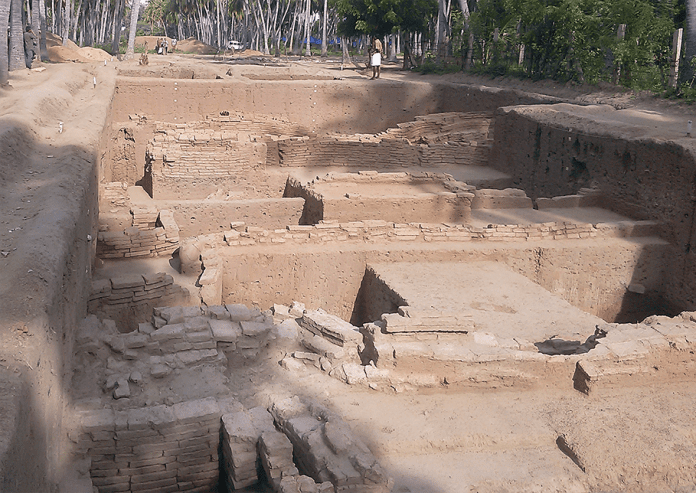 Keeladi — an archaeological site in Tamil Nadu's Sivaganga district — has thrown up several 'princes' vying with each other to draw a picture of what Keeladi was 2,500 years ago based on a single carbon dating.
Keeladi — an archaeological site in Tamil Nadu's Sivaganga district — has thrown up several 'princes' vying with each other to draw a picture of what Keeladi was 2,500 years ago based on a single carbon dating.A famous Tamil folktale speaks about a prince who is able to draw a life-like portrait of a princess based on a lock of her hair. Keeladi — an archaeological site in Tamil Nadu’s Sivaganga district — today is like the princess of the folktale. Recent findings about artefacts from the site have thrown up several ‘princes’ vying with each other to draw a picture of what Keeladi was 2,500 years ago based on a single carbon dating.
The pictures they have drawn are about as authentic as the one in the folk tale.
Last week, the Tamil Nadu Archaeology Department (TNAD) announced that artefacts unearthed during excavations at Keeladi could be dated to a period between 6th century BCE and 1st century CE, nearly 300 years earlier than previously believed — 3rd century BCE. The findings also “push back the date of Tamil-Brahmi script to another century, that is, the 6th century BCE”.
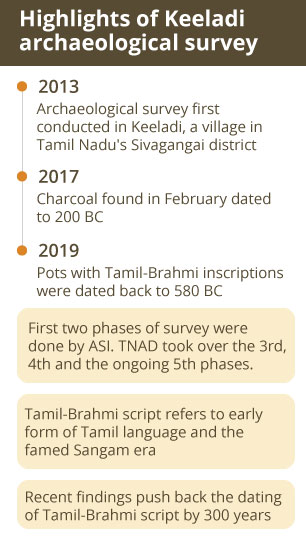
The TNAD, on its part, has printed a book on Keeladi both in Tamil and English that speaks about the excavations done by their archaeologists at the site. The book, I understand, is not yet available in print but a friend has sent me a digital version and I am basing this article on the information available in it.
Is Keeladi unique?
Keeladi, though it may sound surprising to many Tamil zealots, is part of Indian civilisational panorama which is at least as old as the Indus Valley days.
The Tamil country may have skipped the bronze age but as recent articles on Rakhigarhi have shown, but migrations from the north to Tamil Nadu were taking place at least from 1500 BCE. The migrants mingled with locals and the result naturally was an unmistakable cultural and technological overlap.
It is no accident that the black and red pottery found in Keeladi is also found in late Indus culture and is widely distributed in the Gangetic valley and other parts of Northern India. There is nothing unique about the other artefacts either. Beads are found in many archaeological sites. This is not even the first major excavation in Tamil Nadu which is not connected with a burial site.
Kaveripoompattinam and Arikamedu had urban structures and artefacts, which were as significant. Moreover, there are several such sites in India.
Keeladi is certainly not unique.
Is Keeladi part of an ancient river valley civilisation?
Vaigai is a small river that goes dry during summer. As of now, it is hyperbolic to talk about a river valley civilisation, based on the meagre findings in Keeladi.
The present excavations have found remains of animals but no human remains. The human burial sites may have been kept away from dwelling units, but the site doesn’t have any evidence of a significant number of people living there. No regular dwelling units or streets have been excavated. What has been excavated could be a site for activities and there is no evidence that they were thriving as far back as the 6th century BC.
Carbon dating – What does it tell us?
According to the government report, “the six carbon samples collected from the fourth season (2018) of excavations at Keeladi have been sent to Beta Analytic Lab, Miami, Florida, USA for AMS [Accelerator Mass Spectrometry] dating and the reports have been received. The sample collected at the depth of 353 cm goes back to 580 BCE”.
Also read: Keeladi excavations reveals sangam age to be much older than believed earlier
Turn to any book on archaeology and it will tell you that a radiocarbon laboratory takes a chunk of charcoal and finds out how long ago a tree that turned into charcoal died. By itself, this date says nothing important about the site from which it is taken. Thus, the date of 580 BCE has nothing to do with the other artefacts found in Keeladi, including the pot bits with Brahmi characters.
Let us listen to what the Keeladi archaeologists themselves say: (T)he chronology of this site Keeladi with three periods could be scientifically fixed between 6th century BCE and 11, 12th century CE. In this context, period-I represented the cultural settings of the site from 6 century BCE to 3rd century BCE. While period-II existed between 3rd century BCE and 4, 5th century CE, the last phase, period-III, constituted the finds belonging to date from 4, 5th century CE to 11, 12th century CE. Hence, period-I is the earliest phase found at the lower level of the deposit and consequently the other two over it.
Thus, the artefacts gathered from Keeladi could be dated anywhere between 6th century BCE and 12 century CE — a period of 1,800 years.
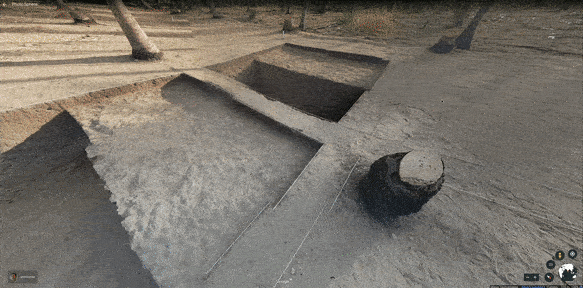 A 360 degree view of the archaeological excavation site at Keeladi in Sivagangai district of Tamil Nadu.
A 360 degree view of the archaeological excavation site at Keeladi in Sivagangai district of Tamil Nadu.Potsherds with Tamil Brahmi inscription – What do they say?
The digging was done in 11 trenches. The report says this about one of the trenches (A3/2): “In fact, the top portion was completely filled and packed with cart load of ceramic tiles and to everyone’s surprise, an almost full shape like black and red ware vessel was found embedded. The clear-cut marks vertically on the western end was suggestive of the dig at a later period and dumped with such huge amount of discarded potsherds.”
Thus, Keeladi cannot be called an undisturbed site, which makes any dating extremely difficult. Nevertheless, speaking about potsherds with Tamil Brahmi inscriptions, this is what the report says: “Likewise, the date of 5th century BCE is considered as the date of Tamili (Tamil-Brahmi) based on radiometric dates recovered from Kodumanal, Alagankulam and Porunthal excavations. But the recent scientific dates obtained for Keeladi findings push back the date to another century, i.e., 6th century BCE.”
Really?
Radiometric dates obtained at the other sites have been actively disputed by other reputed archaeologists. Harry Falk, a retired Indology professor from Berlin has this to say: “Particularly ill-informed appears Rajan (Professor Rajan who has critically edited the government’s book on Keeladi)… Misrepresenting megalithic logograms for Brahmi writing at Porunthal, he reads va-y-ra (meaning diamond) on a ring stand (which was) carbon dated to 490 BC.”
In Keeladi, there are cartloads of potsherds, but there are just two bits which contain the Tamil Brahmi words குவிரன் அ (ஆ)தன் அ(ஆ)தன் – Kuviran A(Aa)than and A(Aa)than.
Now, there is absolutely no indication in the book about the level at which these bits were found. Nor is there any information on the distance at which the carbon-dated charcoal were located from them. For all we know, they could have been found form trench A3/2, where potsherds were found at the very top level in cartloads.
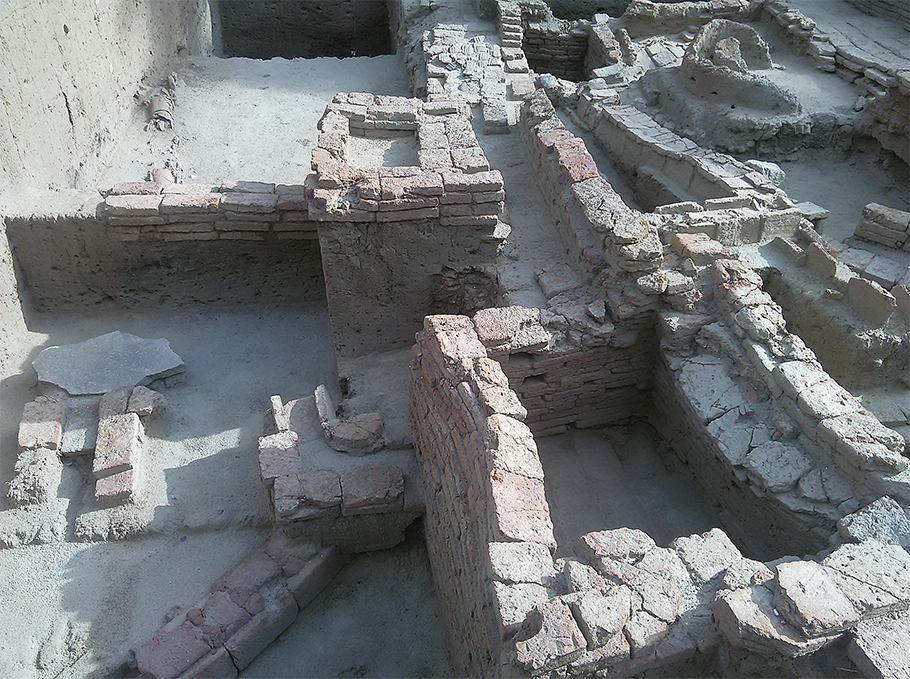 The Keeladi excavation site in Sivagangai district of Tamil Nadu.
The Keeladi excavation site in Sivagangai district of Tamil Nadu.For argument’s sake, let us assume that these were found near the carbon-dated charcoal and at the lowest level of deposit. The archaeologists themselves say that whatever found at this level may belong to the period between 6th century BCE and 3rd Century BCE. Thus, it is amazing that with this scant evidence, a reputed professor says Tamil Brahmi’s date can be pushed back to another century.
Indus Valley Civilization and Keeladi – Are they connected?
Any Indian culture that came after Indus valley civilisation is most likely to have some link or memories connected with it. It doesn’t mean that Keeladi is directly linked to the Indus Valley Civilization. No. The Indus Valley people did not land in Tamil Nadu or Keeladi directly. The attempt to link some Keeladi graffiti with what was found in Indus Valley is pathetic and an insult to common sense.
Was Keeladi without a belief system?
No ancient society in India could have existed without any belief system. If Keeladi was an exception, more evidence would be needed. There are a few excavated terracotta figures which could have been used for religious purposes.
In any case, Sangam period mentions several Hindu gods and, in the subsequent period stretching up to 12 century CE, Tamil Nadu was bristling with Hindu gods. Thus, only an unintelligent person would venture to bet that Keeladi was without a belief system.
Is there an agenda?
The agenda is clear. It is to prove that Tamil Brahmi came to be written much before Ashokan Brahmi was born and that Tamil was the first language to have a written script.
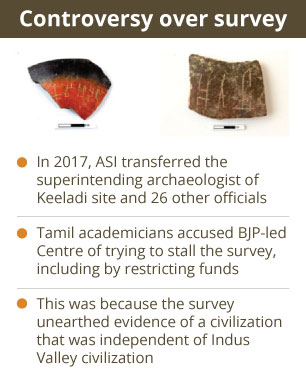
The logic is this — the charcoal bit is dated 580 BCE and hence, the pottery strewn in its vicinity should also be dated identically. Historians and archaeologists with a reputation to defend will consider such a parody of logic with utter contempt.
Let us for a moment assume that Tamil Brahmi came to be written in the 6th century BC. The entire written material on potsherds and rocks for 1,000 years, that is until the 4th century AD, will hardly fill two sheets of A4 size paper.
What’s more, most of the writings are just names — a large number of them are Prakrit names — and full of errors. They contain almost no sociological, political, economic, religious, or cultural information.
Ashokan edicts, on the other hand, are documents of immense value. The Brahmi script used in them is very well developed and it conveys complex ideas in an elegant manner.
Pushing back the date of Tamil Brahmi will only convey that writing in Tamil remained woefully underdeveloped for about one thousand years, while others marched way ahead.
What now?
More evidence is needed to prove that there was a thriving river valley civilisation or an urban civilisation in and around Keeladi. The carbon-dating doesn’t mean that all the artefacts found in Keeladi dates back to the 6th century BCE. The carbon-dating also cannot be superimposed on pot-bits with Brahmi inscriptions to date them to 6th century BCE. Moreover, there is absolutely no evidence that Keeladi is directly linked to Indus Valley civilisation.
Also, no ancient societies could have existed without a belief system. If Keeladi was an exception, more proof would be needed.
(The writer is a former bureaucrat, author and a history enthusiast)




